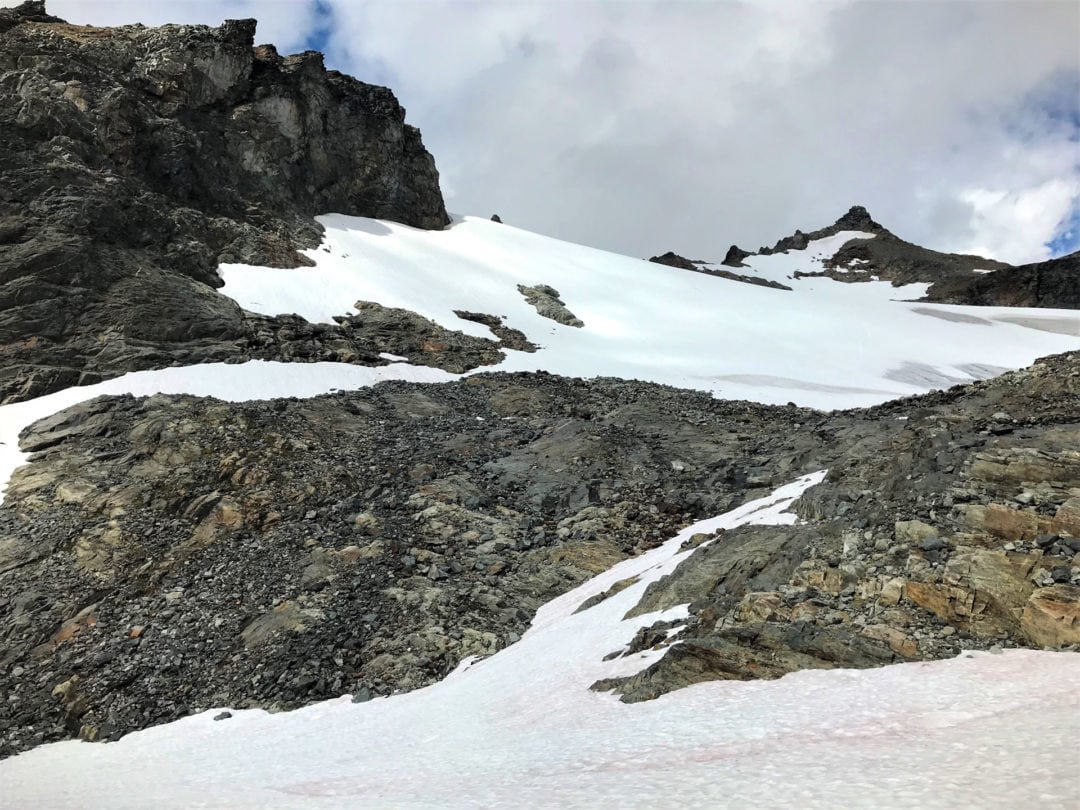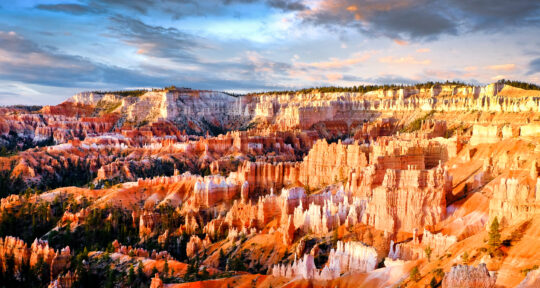There are six miles of wilderness between the Cascade Pass trailhead and the Sahale Glacier and every inch of it is impossibly beautiful.
The peaks of Washington’s North Cascades National Park are jagged and saw-toothed, carved by millennia of frozen ice and thawing meltwater. They explode out of the earth like arrows, some so steep they’re nearly vertical. In the distance, ancient glaciers wink in the sunlight—it’s August when I visit—a bluish tinge to the ice. The “cirques” they form are natural amphitheaters that showcase the tundra.
There are more glaciers at North Cascades National Park than anywhere else in the contiguous United States, but here, like in every alpine environment around the world, they are in trouble. The rapid rate at which the glaciers are melting threatens not just fragile mountain ecosystems but the world as a whole. Because they are so sensitive, glaciers “are often called the canary in the coal mine,” according to Dr. Jon Riedel, a geologist with the National Park Service at North Cascades National Park. Glaciers are among the first ecosystems to feel the impact of climate crises. But while researchers expect profound changes in the North Cascades in the next 50 or 100 years, exactly what will happen when, not even Riedel can say.

Carnivores in the Cascades
I’ve been hiking for well over an hour when I finally emerge from the tree-lined switchbacks up the mountainside toward Cascade Pass, and it’s like staggering into a painting. The rugged landscape that appeared in snatches through the forest is suddenly fully visible as the trail levels out to skirt around a rocky moraine left behind by ages of ice and snow.
Just a little further ahead is the pass. Given the sheer beauty around me, on a warm summer day this trail should be just as packed as any I’ve hiked in Yosemite National Park or Rocky Mountain National Park. It’s not. Only around 30,000 people per year visit North Cascades National Park, compared to the 4 million plus visitors annually to Yosemite and the Rocky Mountains.
Of those who are on the trail, most are congregated around the stone benches overlooking the spectacular glacial cirque at the Cascade Pass, a valley of soft greens and blues ringed by craggy, snowy peaks that extend all the way to the horizon. I’ve just sat down to take in the view when a hiker calls out, “Bear! I see a bear!” A dozen sweaty heads snap left all at once, eyes straining to get a look. There she is, black and furry, maybe 300 feet away, walking casually up the trail toward the Sahale Glacier.

Carnivores like the black bear are an essential part of the montane ecosystem of the North Cascades and the changing climate is likely to have a major impact on which of the park’s carnivore species thrive and which decline in the coming years.
“I like to think about carnivores as being this icon of the wild because when we lose carnivores, which has happened in various places in Washington, then we don’t have a complete and balanced ecosystem,” says Jocelyn Akins, conservation director of the Cascades Carnivore Project, a collaborative non-profit that investigates, raises awareness around, and helps to develop conservation strategies throughout the Cascade Mountains.
The group’s primary focus is on three of the region’s rarest carnivore species: the wolverine, the Canada lynx, and the Cascade red fox. The Cascade red fox is typically found south of the region’s major dividing highway, I-90, while wolverines are mostly found north of I-90. Though the recent opening of wildlife corridors across the interstate should help give these rare species safe passage, “it’s a major problem if there is just a limited number of foxes north of I-90 and the ones south can’t get across the highway,” says Akins.
Melting glaciers
Compared to the lynx, wolverine, and red fox, black bears are plentiful. Over the next two hours, I follow “mine” at a safe distance as she glides elegantly across the mountainous meadows, turning over rocks and rooting around the brush looking for lunch. Marmots, a carnivore delicacy, are out by the dozens and when I pause on a rock outcropping to catch my breath, one makes a beeline straight for me. Not quite knowing what to do, I try reasoning with the rotund 15-pound ground squirrel. “Slow down, buddy,” I call cordially. He does not. I begin to frantically wave my arms and stomp my boots wondering just how it feels to be head-butted by a marmot. Finally, just inches from me, the marmot turns mid-stride and scuttles off under a bush. I giggle with relief.

Field cameras strategically placed on this trail by the Cascades Carnivore Project keep an eye on the marmots and the hungry carnivores who feast on them during the three to four months they are out of hibernation each year. Researchers are hoping to learn more about just who is making a meal out of the fleshy rodents.
Because climate change warms the mountains and hardens the snowpack, species that are not adapted for snow are more easily able to move through the mountains, Akins explains, creating new competition for snow-adapted species like wolverines, red foxes, and lynx. Already the rarest of the bunch, these carnivores are increasingly facing stressors to their food supply that never existed in the past.
The glaciers, too, are part of the alpine food web, says Riedel. Not only are they habitat for species like the ice worm, which can rise from the ice by the millions to feed in the evenings, the water that runs off of the glaciers is also a crucial part of the regional ecosystem. “We get a ton of snow in the winters that is largely melted away by the end of July or August, so then it’s the glacial melt water that keeps the rivers flowing, the waterfalls roaring, and supports the salmon runs. They buffer our springs and lakes from drought,” says Riedel.

But over the last 50 years, the delicate balance in which winter ice and snow shores up the glaciers before a portion is released into waterways in drier, warmer months has shifted. All of the park’s 312 glaciers are receding, melting at different rates depending on factors like elevation and from which side of the mountain they face the sun. “These rivers that are fed by glaciers are losing a source of fresh water at a critical time of year, so that has a ripple effect on the aquatic ecosystem … all the way down to the ocean,” explains Riedel.
Changing ecosystems
As I top the final ridge to the Sahale Glacier, the wind smacks me full in the face. For the first time on this hike, I really feel the cold. It radiates in waves from the ice field at my feet. Sahale isn’t one of the glaciers Riedel and other researchers are closely monitoring, but like its icebound brethren, it too is melting.
Riedel isn’t willing to speculate on the specifics of what may happen to the Cascades’ glaciers in the future. There are just too many variables—emissions levels, volcanic activity, and other factors—to know exactly how the park will look 50 or 100 years down the road. The effect of glacial decline on everything from rural regions to large cities, however, will be profound. “We’re going to see changes. We’re going to see more stress to ecosystems that depend on water, including human ecosystems,” says Riedel, which will impact not just access to clean drinking water but the agricultural and fishing industries, as well.

As I pick my way back through a glacial moraine littered with boulder-sized stones, shadows from a slowly setting sun draw long across the North Cascades. By the time I reach Cascade Pass, only pikas and ptarmigans are still scrambling among the rocks. The other hikers have all gone home. In the gloaming, the glaciers keep watch over my retreat down the mountain, just as they have for centuries, millions of ice worms dancing on their surface.







